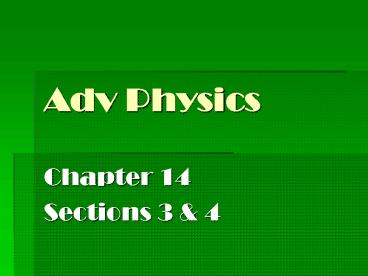Adv Physics - PowerPoint PPT Presentation
1 / 16
Title: Adv Physics
1
Adv Physics
- Chapter 14
- Sections 3 4
2
Mirror Math
- Mirror equation
- 1/f 1/do 1/di where f focal length
- do
object dist -
di image dist - Magnification equation
- m - di / do where m - magnification
3
Sample Problem
- A 2 cm high object is placed 7.1 cm from a
concave mirror whose radius of curvature is 10.2
cm. Find the position of the image and its size.
4
Sample Problem
- An object is placed 6 cm in front of a concave
mirror that has a 10 cm focal length. Determine
the location of the image. If the object is 1.2
cm high, find the image height.
5
Sample Problem
- A convex mirror is used to reflect light from an
object placed 65 cm in front of the mirror. The
focal length of the mirror is 45 cm. Find the
location of the image and its size relative to
the object.
6
Sign Conventions
7
Spherical Aberration
- Shape distortion resulting in a blurry image
- Caused by rays that reflect from points on a
mirror far from the principal axis converge at
slightly different points
8
Spherical Aberration
- Corrections
- use mirror with small diameter so no
- rays are far from the pa
- cover/block edges of mirror
- parabolic mirror
9
Parabolic Mirror
- Mirror that is a segment of a paraboloid (3D
parabola) - All rays parallel to the pa will converge to f
regardless of where they strike the mirror - Used in reflecting telescopes, flashlights,
headlights
10
Opaque
- Object that doesnt allow light to pass through
it - Color reflected is what we see
- All other colors are absorbed
- White all colors reflected
- Black all colors absorbed
11
Transparent
- Object that allows light to pass through it
- Color transmitted is what we see
- Clear all colors transmitted
12
Color Mixing
- White can be produced with only red, green and
blue light - Additive primary colors- red, green and blue
light - - combine to produce white
- Various combos of the primary colors and varying
intensities can produce all the colors of the
spectrum
13
Color Mixing
- Complementary colors two colors of light that
when added together produce white
14
Color Mixing
- Red green yellow
- Green blue cyan
- Red blue magenta
- Yellow blue white
- Cyan red white
- Magenta green
- white
15
Color Subtraction
- Pigments mix differently than light because they
use a subtractive process - Subtractive primary colors magenta, cyan and
yellow - - combine to make black
16
Color Subtraction

